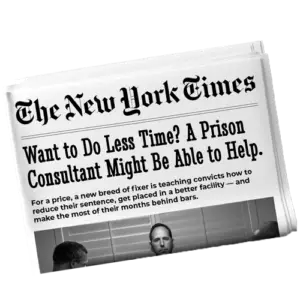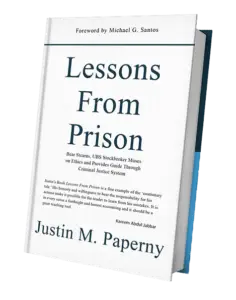“My lawyer says it makes sense, but nothing moves this judge. He’s a guideline guy.”
“I made him watch it. I think he may be mad at me… BUT HE AGREES!”
“I got a C plea, so doesn’t apply to me. Agree?”
And then this:
“Your stop-calling-your-lawyer video is my favorite ever. I sent him three emails and now I have my first meeting with him in months. You rock.”
Most people under investigation wait. They wait for the government to file charges. They wait for the presentence interview. They wait for sentencing. Then they panic and throw something together—a letter, a few testimonials, maybe some weekend volunteer hours.
By then, the record is already built. And so is the perception.
This webinar isn’t about writing a good statement or making a final pitch in court. It’s about influencing people who will make decisions about you—for months, years, and possibly decades.
That includes your probation officer. The judge. The prosecutor. The BOP staffer reading your file five years from now. And yes, your lawyer.
We’re using two books as a foundation for this webinar:
- Pre-Suasion by Robert Cialdini
- The 33 Strategies of War by Robert Greene
These books explain how people form judgments. And how the timing and framing of what you present matters more than how polished it sounds.
PART 1: SIX PRE-SUASION STRATEGIES
1. Privileged Moments
Cialdini shows that the most persuasive moment is not when you’re speaking. It’s the moment right before someone decides to listen.
People form impressions quickly. That first contact—whether it’s how you are dressed, a professional demeanor, a summary of what you have done—sets the tone for everything that follows.
“The individual who knows how to time a request, recommendation, or proposal properly will do exceedingly well.”
Example 1: Before your presentence interview, don’t just show up with your hands like a deer in headlights. lead: Complete the forms and include a one-page document listing what you’ve done since pleading guilty:
- How many therapy sessions you’ve attended
- The amount of restitution you’ve paid
- Who you’ve been working or volunteering with
- Documentation showing someone is tracking your progress
Show what exists before they default to the government’s version of you. Words mean very little: they are used to doubting your words.
Example 2: When you submit your narrative, don’t just attach it. Frame it properly and do not ask for permission to improve your own life.
“I know you’re busy, and I’m afraid this might be too long. But I’ve spent hundreds of hours working on this to help you understand the harm I caused, the shame I feel, and what I’ve done since my guilty plea. I wrote this after watching several interviews with federal judges who suggested defendants explain what they’ve done and what they intend to do. This is my first attempt. Thank you for reading it.”
2. Channeling Attention
What people see first becomes what they think matters most.
If you lead with a resume, they’ll assume that’s your priority. If you lead with blame, they’ll expect excuses. If you lead with authenticity and ownership, they’ll look for signs that you mean it.
Example 1:
“When I was first indicted, I stayed in denial. I blamed others. I didn’t change. It wasn’t until I began working with my lawyer and reviewing my conduct that I understood what I did. I created victims. I’m responsible for that. This letter isn’t about explaining it away. It’s about documenting what I’ve done since.”
Example 2: If your therapist writes a letter, don’t let it read like a template or form letter. Ask for details:
“This patient has attended 24 sessions since January. He arrives on time, participates, and follows through with journaling and assignments. He has acknowledged his conduct and worked to understand the patterns that led to it.”
3. Association
Cialdini explains that people don’t judge your actions in isolation. They interpret what those actions suggest—and who they believe you are when they see them.
If they see shared values in your decisions, they’re more likely to trust you. If they recognize something familiar—responsibility, consistency, service, humility—they become more willing to help.
If you pay restitution, volunteer, or seek therapy, and it’s framed as “damage control,” it gets ignored. If the same actions are tied to personal ownership, they become meaningful.
Example 1:
“Driving for Uber at 47 years old isn’t what I thought I would be doing after medical school. But I must embrace this opportunity and be grateful. I am making enough to pay my rent, healthcare and to date I have said aside $10K for restitution. It is not a lot but it is a start.”
Example 2: (I wrote on behalf of a lawyer who shared with Judge, who appreciated the effort).
“He’s not eligible for RDAP. That didn’t stop him from borrowing money from family to pay for private counseling for his Xanax addiction. He knows his sentence length is not the issue. He’s focused on addressing what caused the behavior.”
4. Anchoring
Anchoring is how you control the first impression.
Cialdini shows that early framing becomes the reference point.
Malcolm Gladwell calls it thin slicing—how people form fast judgments based on very little information.
Judges and probation officers do it constantly. They don’t wait for the last paragraph. They see one sentence, and the direction of your file is already forming.
You don’t control the fact that they will judge you quickly. But you can control what they see first.
Let’s talk about how this applies to community service.
I often hear, “My lawyer said not to do it—it looks fishy.”
That happens when people present it the wrong way. They open with hours, with photos, or with praise from others—before saying anything about what they damaged.
If victims were created, victims come first.
Start there. If you hurt people, acknowledge that clearly. Before your degrees. Before your therapy. Before your progress.
Community service means nothing if it looks like a distraction from the people who were harmed. That’s the mistake most defendants make.
David Moulder understood that.
He didn’t lead with output. He led with hesitation—his own, and his family’s.
“My wife was skeptical about me doing community service work after pleading guilty. She thought it looked kind of contrived or a ploy. Can I tell you how I found this nonprofit and why I will be involved for years and years to come?
After I pled guilty, my lawyers told me I was going to prison. I didn’t know anyone who had been to prison. They sent me a link to the Bureau of Prisons website to learn more about the federal prison camp in Duluth, Minnesota. While reading about Duluth, I came across an article featuring someone who had served a long sentence. He was working with the BOP, traveling across the country and speaking in prisons. I assumed he must have had the endorsement of the BOP, and I was impressed by that.
Later, I learned he created a course called Preparing for Success After Prison, and that it was being used in every federal facility. I Googled him, found contact information, and reached out. I said something along the lines of: I have time. I’m fortunate to have resources. I’ve paid my restitution. I’m semi-retired. But I’m looking for a way to make meaning from this experience. I wasn’t calling to write a check—I was offering time.
That led to a series of conversations and ultimately to working together to build a new curriculum. I can’t claim to understand the full extent of its reach, but I do know it’s being used in jails and prisons across the country. And I’ve seen that people are finding value in it. That’s something I’m proud of.
I remember watching an interview with a federal judge who said, ‘If you break my window, don’t just say sorry. Tell me how you’re going to fix the window.’ That resonated with me. Paying restitution and pleading guilty might be necessary—but it’s not enough. It doesn’t fix the window.
For me, the window included damage to trust, to the people around me, and to people I’ll never meet. I’ve spent more than 40 years in business. If I can draw from those experiences to help someone in prison or coming home from prison, I think that’s one small way I can fix part of what I broke.
I’m aware that most people who leave prison don’t have the same opportunities I’ve had. That’s part of what motivates me to contribute to this nonprofit. And I can say clearly: regardless of what happens at sentencing, I will continue doing this work. I’ll continue to give time, and I’ll document that progress in the weeks, months, and years ahead.”
He didn’t start with hours. He started with why he showed up.
That’s anchoring.
Why Anchoring First Works Better
When you lead with what was built—not what it’s called—you give the reader a fresh frame. You interrupt the usual association with last-minute volunteerism and reposition the work as strategic, personal, and long-term.
If you wait until paragraph four to say, “He did community service,” you’ve already lost ground. Their brain fills in the blank: soup kitchen, food drive, a few logged hours. Now you’re trying to explain why your service is different, but it’s too late—they’ve already put it in a box.
Instead, anchor like this:
He reached out and said: I’m not looking to write a check. I’ve already paid restitution. I’m not trying to impress anyone. I want to offer my time. I have experience. I want to build something that might outlive my case.
Then follow with:
That turned into a curriculum. It’s now used in jails and prisons across the country.
Only after you’ve shown what it is—and what it does—should you name it:
When his probation officer later asked what he was doing for community service, he didn’t need to explain or spin. He had documentation. He had outcomes. He had someone else signing off on the work.
Cialdini’s Principle: Pre-Suasion + Anchoring
“To be effective, a communicator must pre-suade by arranging for recipients to be receptive to a message before they encounter it.”
Anchoring does exactly that.
You’re not just describing work. You’re setting up the lens through which the decision-maker will interpret that work.
Label: Only after the value is felt do you apply the familiar term—“community service.”
Anchor: Show the intention, effort, or reach of the work.
5. Questions
Cialdini’s research showed that smart questions lower resistance and increase cooperation.
Instead of pushing for results, ask for direction. Ask what’s useful.
Example:
“If I send weekly updates, will that make your job easier?
I sent one last week about how and why I began volunteering with PrisonProfessors.org. You haven’t responded. I know you’re busy—but Judge [insert name] has granted downward departures for similar work. Can we speak tomorrow at 3 or 4 p.m. Eastern to review it?”
6. Unity
People trust others who are already being held accountable.
If you’re doing this alone, it looks unstable. If people are watching your work—tracking it, signing off, expecting results—it carries more weight.
Example 1:
“Every Sunday I send a summary to two people—my sponsor and my brother. They agreed to keep me on track, and I take that seriously.”
Example 2:
“He works under my supervision. I see his hours. I review his progress. If he misses something, I know. I’m aware of what the headlines say. But I know the person who shows up here every week. He does what he says he’ll do.”
ONE-WEEK ACTION PLAN
| Day | Task |
|---|---|
| Monday | Ask your lawyer: “Would weekly updates help avoid last-minute prep?” |
| Tuesday | Rewrite the first paragraph of your statement. Lead with what you broke. |
| Wednesday | Ask your therapist: “What part of our work would help support the PSR?” |
| Thursday | Ask for a letter. Don’t say “character.” Say: “Write about what I’ve done since my plea.” |
| Friday | Read your release plan out loud. Does it include jobs, check-ins, and supervision? |
| Saturday | Put your documents in one folder. Review them like a judge would. Fix anything that doesn’t match. |
| Sunday | Send your update. One page. Three bullets: What I Did. What I’m Working On. What’s Next. |
Every person reading your file—your PO, your judge, the prosecutor, the BOP staff—has seen the same last-minute scramble. If you sound like everyone else, you’ll be treated like everyone else.
Start now. Not when your lawyer tells you. Not when the sentencing memo is due. Now.
You don’t need permission to do the work. You just need to start showing it.
If you want our help building your system—your narrative, your service documentation, your strategy—join us on Tuesday’s webinar or schedule a call. We’ll walk you through how we’ve helped others and what it would look like to start today.
But even if you don’t reach out, don’t wait.
Stakeholders are already forming impressions. This is your chance to change what they see.
Justin Paperny



